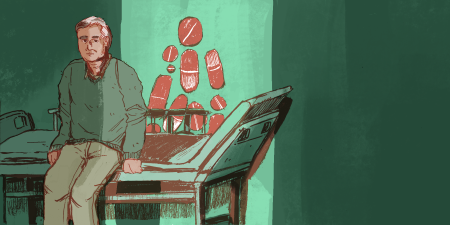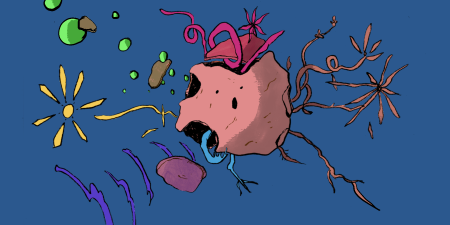Abstract
Treatment-resistant schizophrenia can create a high disease burden for some patients, making it challenging for all involved to navigate a good outcome. Such cases require physicians to regard symptom eradication and treatment success as the same. This commentary on a case considers a palliative psychiatry approach grounded in the well-being of patients and inclusion of all stakeholders in decision-making processes.
Do good and avoid evil is the primum principium of all ethics.
Edmund Pellegrino1
Case
Mr M is a 45-year-old man with schizophrenia, type 2 diabetes requiring insulin, and hypertension, who is admitted to the psychiatric hospital for the second time in 10 months after he poured flammable liquid on himself in an attempt to burn his body. Prior to admission, the patient believed worms were crawling out of his skin and thought burning himself would be curative. His positive symptoms include somatic delusions and auditory hallucinations, and his negative symptoms include flat affect, avolition, and complete social withdrawal.
Mr M’s psychiatric illness started in high school and has become progressively worse, resulting in 15 psychiatric hospitalizations throughout his lifetime. He’s tried both first- and second-generation antipsychotic oral medications and long-acting injectables with minimal effect and has had no additional benefit from electroconvulsive therapy. He previously tried clozapine, which decreased delusion intensity but was stopped because he was sedated and had some falls due to postural hypotension. This high disease burden has resulted in his father becoming his guardian for health care, among other matters.
The treating team retrials clozapine and sees cessation of self-injurious behavior, yet optimal therapeutic levels have not been attained, and Mr M’s delusions persist. This situation prompts the team to continue to aim for a therapeutic dose. Regrettably, while titrating the dose, Mr M experienced a fall during his father’s visit. This event triggered a meeting with Mr M’s father and the care team to discuss his care and plans for potential discharge. During the meeting, Mr M’s father explained that, due to this incident and side effects from a prior clozapine trial, he would not give consent to continue increasing the dosage of clozapine, stating: “We are done here. I’ve been down this road before, and I don’t want him to be hurt anymore. You doctors just need to hear me, we’re done, he’s coming home.”
Despite the team’s efforts to convince Mr M’s father that the fall was in no way indicative of the need to stop treatment with clozapine and that continuing to titrate, albeit slowly, was within the standard of care, Mr M’s father remained emphatic: he was done. The meeting ended with no agreed-upon plan of care. The clinical team members, distressed by this impasse, decided to call an ethics consultation, stating that they did not see a way forward to resolve this situation and wondering if Mr M’s father truly understood the gravity of Mr M’s position.
Commentary
In this case, the treating team and Mr M’s father, the legally appointed guardian, are at an impasse regarding how to continue care. The team members remain distressed over their inability to convince the father, who protests that he does not want his son “to be hurt anymore,” to continue a trial of clozapine and see this incident as a failure to have their expertise as clinicians accepted.
Analysis of this case centers on the tension between the respect for autonomy—in this case, the autonomy of the father on behalf of the son—and the clinical team’s duty to promote a good outcome, or beneficence. Regrettably, neither party knows with certainty what Mr M would want for himself, and thus a best interests standard will guide the deliberation. Maximizing benefit while minimizing harm demands that both the treating team and the proxy decision maker assess the risks and benefits of the proposed plans and identify a plan that yields the highest utility, thereby shifting the focus toward quality of life.2 Yet, while each of the parties recognizes this obligation to all involved, their proposed actions appear incongruent. How ought we to proceed?
Beneficence
In this case, we begin by asking what is the father’s and the treating team’s prima facie duty in creating a plan of care for Mr M when his desires are not known. The application of the best interests standard has extensive support.3 This standard “requires acceptable and reasonable choices grounded in a web of established duties” to incompetent as well as incapacitated persons.3 The team’s and Mr M’s father’s duties and obligations to Mr M can be addressed through application of the best interests standard.
Kopelman identifies 3 considerations when applying the best interests standard.3 Firstly, what are the interested parties’ prima facie duties related to weighing the benefits and burdens of the proposed decision? Secondly, is the recommendation “good enough” in the sense that a reasonable and informed person would arrive at a similar conclusion? And, lastly, does the recommendation reflect both the moral and the legal duties we owe to someone who is no longer able to self-advocate? Approaching this case with these considerations in mind serves to guide ethical decision making.
Clozapine, while indicated for treatment-resistant schizophrenia,4 might reduce Mr M’s quality of life by leaving him overly sedated and in need of ambulatory assistance, but discharging him home without consensus regarding treatment goals is equally problematic. Is clozapine, with its attendant side effects, conducive to the quality of life that clinicians want for their patients even if it is an evidence-based solution? While this case is complicated, its resolution requires a shift in clinical thinking from equating symptom remission with quality of life to ensuring the well-being of Mr M and the inclusion of all stakeholders in the decision-making process about his care. The shift to a person-centered approach focuses on engagement of the family, patient, and treatment team in the decision-making process about a care plan that is collaboratively achieved; centered on both physical and emotional well-being as well as on family preferences, values, and cultural traditions; and shared in a timely and transparent manner.5
Analysis
The issues and points of conflict in this case center on collaboratively identifying the good while avoiding harm. Traditionally, in clinical encounters, “the physician … offers to heal, help, care for, or comfort a sick person.”1 Moreover, such acts represent the embodiment of “[t]he well being of the patient … the good end of medicine and of the physician’s art and action” (emphasis added).1 However, it becomes difficult to reconcile the “cure”—in this case, symptom remission—with the good end of medicine, since symptom remission may not be possible. Simply put, for the physician, the clinical team, and the father, to discover the moral ends of medicine is to discover that while “[c]ure may be futile … care is never futile.”1 On this view, considering palliative care is the ethically optimal approach.
In Mr M’s case, shifting to palliative psychiatry represents ethically appropriate action for his discharge. While explicit guidelines regarding the shift to palliative psychiatry are lacking, the focus on prioritizing quality of life is central to good patient care. While palliative psychiatry is a relatively new approach to care, it does not imply giving up on caring altogether; rather, it reflects a shift in the goals of care,1 one that I argue embodies the good. As to the moral and legal duties the stakeholders share, “the good must be the focal point and the end of any theory or professional action claiming to be morally justifiable.”1 The moral end, in this case, is to reduce Mr M’s pain and suffering by taking an ethically permissible action (one that does not violate the law) and, as Strand et al note:
Explicitly switching to a palliative treatment route—with continued pharmacological maintenance treatment in reasonable doses in combination with an increased focus on symptom management and quality of life interventions—could potentially instil hope, increase autonomy, and improve overall outcomes for patients with treatment-refractory schizophrenia or other chronically disabling psychotic disorders.4
Assuming that the treating team, Mr M’s father, and the ethics consultant are all in agreement that Mr M can be discharged with palliative psychiatry, the optimal balance of pharmacological, psychotherapy, and psychosocial rehabilitation could include continued monitoring of clozapine as well as other interventions, such as acceptance commitment therapy (ie, an evidence-based cognitive behavioral therapy that utilizes acceptance and mindful-based strategies) and social skills training.4
References
- Pellegrino ED. The internal morality of clinical medicine: a paradigm for the ethics of helping and healing professions. J Med Philos. 2001;26(6):559-579.
-
Beauchamp TL, Childress JF. Principles of Biomedical Ethics. 8th ed. Oxford University Press; 2019.
- Kopelman LM. The best interests standard for incompetent or incapacitated persons of all ages. J Law Med Ethics. 2007;35(1):187-196.
-
Strand M, Sjöstrand M, Lindblad A. A palliative care approach in psychiatry: clinical implications. BMC Med Ethics. 2020;21:29.
-
What is patient-centered care? NEJM Catalyst. January 1, 2017. Accessed February 18, 2023. https://catalyst.nejm.org/doi/full/10.1056/CAT.17.0559



